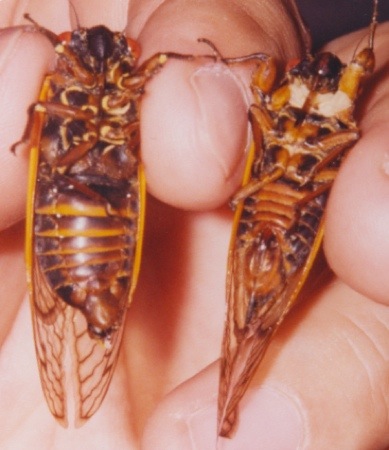When photographing adult Magicicadas, particularly if you are interested in identifying their species and gender, it is important to photograph them from multiple angles: ventral (bottom) and lateral (left or right) particularly near the head. Please take photos of the dorsal (top), anterior (front), posterior (hind) and other angles, however ventral and left or right are the best sides to help identify the species.
We also encourage you to clean your fingernails and include an item which can be used to determine the size of the insect, like a ruler.
The ventral view allows us to determine the species and sex.
The following photo features a male (left) and female (right) Magicicada septendecim (Linnaeus, 1758). Note the orange striped abdomen, characteristic of the M. septendecim. Also, as with other cicada species, note that the female’s abdomen comes to a point, and the male’s abdomen is thicker and ends with a “blocky-shaped” structure.

The following photo features a female (left) and male (right) Magicicada cassini (Fisher, 1851). Note the lack of distinct orange stripes on the abdomen, characteristic of the M. cassini. Their abdomens are nearly completely black. Also note that the female’s abdomen comes to a point, and the male’s abdomen is thicker and ends with a “blocky-shaped” structure.

Both these images were taken by the same photographer (Osamu Hikino) and we can use the size of his fingertips (nice clean nails) to compare the size of these two species. The M. cassini is relatively much smaller than the M. septendecim, which is why M. cassini is also known as the “dwarf cicada”.
I don’t have a good photo of the third species, the Magicicada septendecula Alexander and Moore, 1962 [view a photo of M. septendecula on another website]. The M. septendecula is similar to the M. cassini in size (hence smaller than the M. septendecula), but it has orange stripes like the M. septendecim, which is why it is important to get a photo of the left or right side of the insect so we can see the color of the pronotal extension.
The pronotal extension is an extension of the pronotum that lies between the Magicicada’s eye and its wing (outlined in green in the photo below). M. septendecim have orange coloring in that area, which gives us a key way to visually distinguish them from M. septendecula.

If you want to learn more about diagnosing the species and gender of cicadas (all species, not just Magicicada sp.) using photographs, track down the document Overview of Cicada Morphology by Allen F. Sanborn of Barry University.
I don’t want to discourage you from taking amazing photos of cicadas in every position and angle possible using all your fancy macro lenses and whatnot. All cicada photos are awesome, but only a few angles help us identify the insect.




